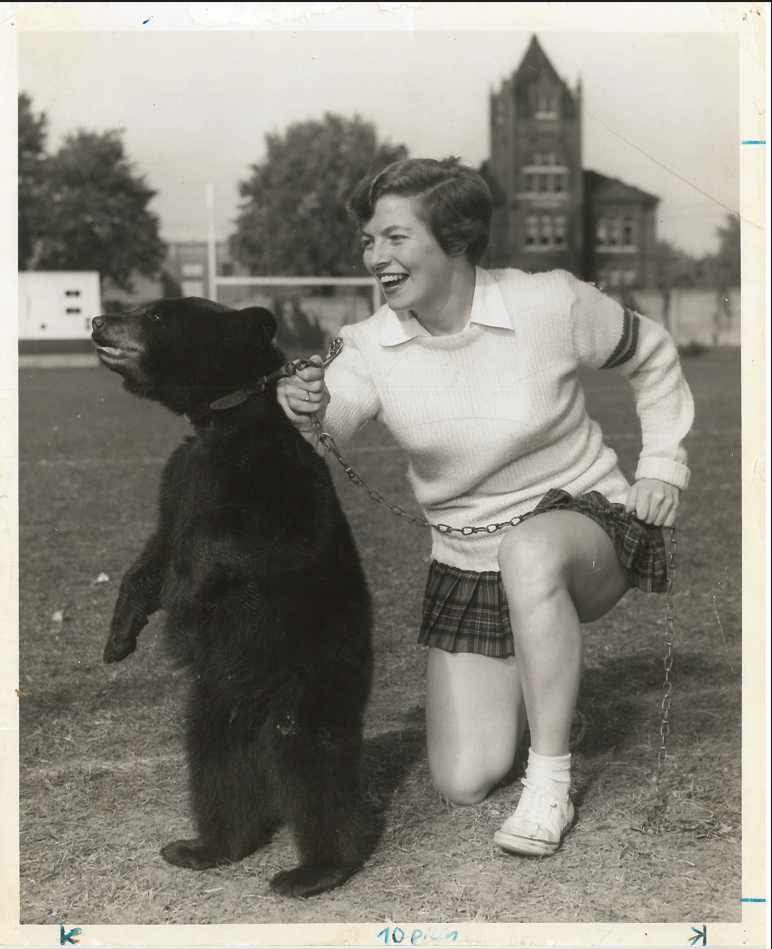Street Address: Cricket Field, opposite the courthouse, former ground used for menageries
Ontario is home to over 85,000 black bears. Because they hibernate through the winter months, losing almost half of their weight during that time, they work hard to find food in the warmer months of the year. Black bears can spend almost eight hours a day foraging for food and enjoy eating berries and nuts.[1] While generally known for being shy around humans, their need for food sometimes brings them into cities, such as in 2021 when black bears were spotted in Gananoque[2] and Brockville.[3] In both these cases, humans were cautioned against approaching the bears and reminded about how to properly manage waste.[4] In the past, however, the fear of bears entering urban areas often prompted hunting campaigns with the goal of eradicating them. This happened in Kingston in 1793 when the city enacted a policy that rewarded hunters with $2 for every bear head they brought in to the authorities.[5]
On the other hand, Kingston has also been home to bears who were actively brought into the city to serve as sports mascots. From the 1920s to the 1950s Queen’s University had a series of bears living on campus. In 1921, the first bear named Gee Whizz was taken from Algonquin Park and a year later another bear, named Boo Hoo, replaced Gee Whizz. This started a tradition of the student society keeping bears named Boo Hoo as sports mascots. Fed a diet of sugary treats and paraded around in chains, these bears were poorly treated by students. Furthermore, when the bears got too big to handle, or too expensive to maintain, the students got rid of them and replaced them with another. There were at least 7 Boo Hoos between 1922 and 1955. Queen Boo Hoo (the first Boo Hoo Bear) was donated to a zoo in New York where she died in 1925. Boo Hoos 3, 4, and 6 were let loose in Algonquin Park when their respective sports seasons were completed. Just imagine what it must have been like to be taken from your home, used for a season, and then randomly dumped park in an area you might not know. Understandably, concerns about the animals’ welfare began to surface so in 1955 the practice of keeping live bears as mascots at Queen’s University was ended. Boo Hoo resurfaced as a mascot again in 1980 but this time as a human dressed up as a bear.[6]
Boo Hoo isn’t the only bear to have been displayed in Kingston. In 1834 a polar bear was brought to the city as part of a travelling ‘Unprecedented Menagerie of Wild Animals.’[7] He was purchased by Gregory, Crane and Co in France to travel to towns across North America, including Kingston. He was paraded around and touted as a symbol of “tremendous ferocity”.[8] One can only imagine how this animal, known to the Inuit as “The Wandering One,”[9] coped with his extreme confinement. Today, polar bears and black bears continue to be confined and displayed in Canadian zoos, and hunting remains a threat with over 40,000 bears killed annually in North America.[10]
Return to the Animal Histories Map


Notes and Credits:
Footnotes:
- [1] Ontario Parks, n.d. “7 Facts about Black Bears”
- [2] Global News, 2021. “Gananoque police advise caution after reported bear sighting”
- [3] The Kingston Whig Standard, 2021. “Bear sightings in north end”
- [4] In 2019 there was an incredible story about a large group of polar bears entering a town in Northern Russia, Ryrkaypiy in search of food
- [5] Macher, A.M., 1908. The Story of Old Kingston. The Musson Book Co. Limited, Toronto (page 64).
- [6] Queen’s Encyclopedia, n.d. “Boo Hoo the Bear”. Thank you also to the work of Deidre Bryden at Queen’s University Archives who has compiled a folder with newspaper cut outs and snippets related to Boo Hoo.
- [7] N.d., “Town of Somers History” 31 May 1834, “Unprecedented Menagerie of Wile Animals.” In The Chronicle and Gazette. Page 1.
- [8] 26 May 1834, page 1, Kingston Chronicle and Gazette
- [9] Polar Bears International, n.d. “Name and Evolution”
- [10] The Winton Foundation, 2022. “American Black Bears”
Extras:
- Black Bears: A Natural History, by Dave Taylor
- Polar Bear, by Margery Fee
- Zoo and Aquarium History: Ancient Animal Collections to Conservation Centers, by Vernon N. Kisling
- New Worlds, New Animals: From Menagerie to Zoological Park in the Nineteenth Century, a book edited By R.J. Hoage And William A. Deiss
- Bear Clan Stories and medicinal plants, by the Wild Center featuring Dave Fadden
- All About American Black Bears, podcast episode on All Creatures Podcast
- A brief history of the zoo, an article by William Mann.











